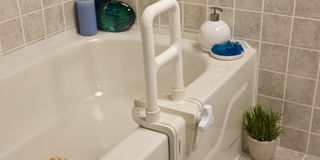Prime
Bathtubs: How safe are they?

Well-placed and properly installed bath grab bars can help with preventing falls. NET PHOTO
Esther Nanyanzi still nurses a broken bone from a fall she had while taking a bath.
“I have used my bathtub for a couple of years and all was well until that fateful evening when I slipped and fell. The pain from the fall is intense and has limited my movements as I cannot walk around my house and garden with ease as I formally did,” she shares.
Risk groups
Dr Franklin Wasswa of Kisiizi Hospital Rukungiri, says risk groups for bathtub accidents are the geriatrics and the paediatrics.
“The elderly, or geriatrics have a higher risk of suffering head injuries than any other group, because as one grows older, their brain shrinks in size inside the skull,” he says.
Owing to this shrinkage, Dr Wasswa says the blood vessels that are attached to the skull and the brain, get taut that any shake of the brain due to a fall will tear or break those blood vessels.
“With that, the person will get a hematoma (blood in between the brain and skull). There are two types; epidural and subdural hematoma and whichever the case, the blood that is gashing into the skull will cause pressure on the brain. This is fatal and can cause death in a few hours if they don’t get medical attention in the right place.” Dr Wasswa says.
Dr Boniface Ssegujja Otto, a paediatrician at Children’s Clinic, Naalya, says it is important be attentive inorder to protect a child from bath time hazards,” Ssegujja says.
Common accidents
Injuries among children include drowning, slips and falls due to the slippery surface which can result in head injuries and fractures, burns due to a hot bath, irritation to a child’s sensitive skin from bubble baths and sponges, choking from the use of small bathtub toys (bid soft rubber or plastic is preferred) as well as skin infections from leaving bathtub sponges wet hence breeding bacteria.
Safety measures
Do not leave a child unattended to as it is sometimes tempting to step away to retrieve a forgotten item while the child is in the tub.
“Leaving a child alone for even a few seconds is too long. Therefore, before you draw a child’s bath, make sure that everything you need is within arm’s reach,” Dr Ssegujja says.
He adds that parents need not offer open access to bathrooms because while most parents know that tubs filled with water are dangerous during bath time, they forget that the whole bathroom actually poses a risk to a young child at any time of the day.
“Tubs as well as toilets pose a drowning risk for these children. So it is important to restrict a child’s access to bathrooms by installing locks on bathroom doors and adding latches to toilets.”
Dr Wasswa says you can have rubber mats that have suckers underneath to give the feet some grip hence avoiding slipping.
“There is also need of having handlebars to help the elderly hold and have a better balance when the feet are slippery.”
He advises against filling the tub, since children can drown in as little as three to four inches of water of their face gets submerged.
Toys that retain water just like sponges are a breeding ground for bacteria. Therefore, you need to ensure they are completely drained and dry.
Safety for the elderly
Dr Wasswa also advises having walk-in bathtubs for the elderly as one will not have to lift one leg into or out of the bathtub.
“Having one limb in the tub that is already slippery and the other in motion of taking a step is the most risky part of tubs because when one leg slips the other follows. However, walk-in bathrooms make it easy to have more stability while getting into the bathtub.”
He adds the need of a mechanical hoister to lift geriatrics in and out of a bathtub.
“This makes it easy and safer for them to use the tub without any risk of falling because that hoister will have a chair where they sit while being locked in like a seat belt and all is safe,” he adds.




